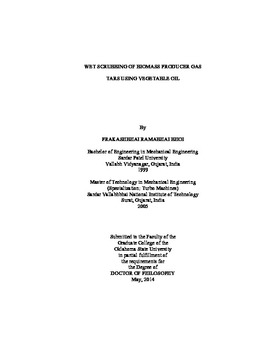| dc.contributor.advisor | Huhnke, Raymond L. | |
| dc.contributor.author | Bhoi, Prakashbhai Ramabhai | |
| dc.date.accessioned | 2015-06-17T20:04:54Z | |
| dc.date.available | 2015-06-17T20:04:54Z | |
| dc.date.issued | 2014-05 | |
| dc.identifier.uri | https://hdl.handle.net/11244/14730 | |
| dc.description.abstract | The overall aims of this research study were to generate novel design data and to develop an equilibrium stage-based thermodynamic model of a vegetable oil based wet scrubbing system for the removal of model tar compounds (benzene, toluene and ethylbenzene) found in biomass producer gas. The specific objectives were to design, fabricate and evaluate a vegetable oil based wet scrubbing system and to optimize the design and operating variables; i.e., packed bed height, vegetable oil type, solvent temperature, and solvent flow rate. The experimental wet packed bed scrubbing system includes a liquid distributor specifically designed to distribute a high viscous vegetable oil uniformly and a mixing section, which was designed to generate a desired concentration of tar compounds in a simulated air stream. A method and calibration protocol of gas chromatography/mass spectroscopy was developed to quantify tar compounds. Experimental data were analyzed statistically using analysis of variance (ANOVA) procedure. Statistical analysis showed that both soybean and canola oils are potential solvents, providing comparable removal efficiency of tar compounds. The experimental height equivalent to a theoretical plate (HETP) was determined as 0.11 m for vegetable oil based scrubbing system. Packed bed height and solvent temperature had highly significant effect (p<0.0001) while, the solvent flow rate did not have a significant (p>0.05) effect on the removal of model tar compounds. The packing specific constants, Ch and CP,0, for the Billet and Schultes pressure drop correlation were determined as 2.52 and 2.93, respectively. The equilibrium stage based thermodynamic model predicted the removal efficiency of model tar compounds in the range of 1-6%, 1-4% and 1-2% of experimental data for benzene, toluene and ethylbenzene, respectively, for the solvent temperature of 30 degrees C. The NRTL-PR property model and UNIFAC for estimating binary interaction parameters are recommended for modeling absorption of tar compounds in vegetable oils. Bench scale experimental data from the wet scrubbing system would be useful in the design and operation of a pilot scale vegetable oil based system. The process model, validated using experimental data, would be a key design tool for the design and optimization of a pilot scale vegetable oil based system. | |
| dc.format | application/pdf | |
| dc.language | en_US | |
| dc.rights | Copyright is held by the author who has granted the Oklahoma State University Library the non-exclusive right to share this material in its institutional repository. Contact Digital Library Services at lib-dls@okstate.edu or 405-744-9161 for the permission policy on the use, reproduction or distribution of this material. | |
| dc.title | Wet scrubbing of biomass producer gas tars using vegetable oil | |
| dc.contributor.committeeMember | Patil, Krushna N. | |
| dc.contributor.committeeMember | Kumar, Ajay | |
| dc.contributor.committeeMember | Whiteley, James R. | |
| osu.filename | Bhoi_okstate_0664D_13360.pdf | |
| osu.accesstype | Open Access | |
| dc.type.genre | Dissertation | |
| dc.type.material | Text | |
| dc.subject.keywords | design | |
| dc.subject.keywords | modeling | |
| dc.subject.keywords | producer gas tars | |
| dc.subject.keywords | removal efficiency | |
| dc.subject.keywords | soybean oil | |
| dc.subject.keywords | wet packed bed scrubber | |
| thesis.degree.discipline | Biosystems Engineering | |
| thesis.degree.grantor | Oklahoma State University | |
